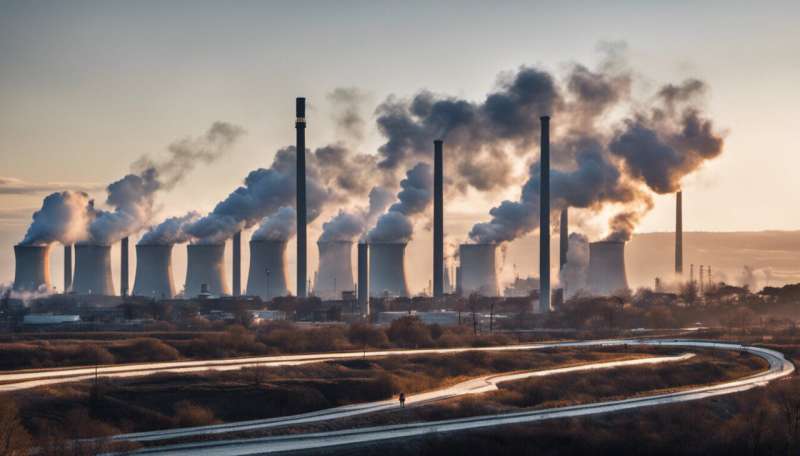This article has been reviewed according to Science X's editorial process and policies. Editors have highlighted the following attributes while ensuring the content's credibility:
fact-checked
trusted source
proofread
CO2 removal is essential, along with emissions cuts, to limit global warming, says report

Carbon Dioxide Removal (CDR) from the atmosphere is crucial to limit global warming, in addition to rapid cuts to emissions—that is the stark conclusion of today's first Oxford-led "State of Carbon Dioxide Removal" report.
More than 20 global CDR experts, led by Dr. Steve Smith, from Oxford's Smith School of Enterprise and the Environment, came together to deliver the blunt findings. In the comprehensive 120-page report, they warn there is a large gap between how much CDR is needed to meet international temperature targets and how much governments are aiming to deliver. But, while the authors found a shortfall in policies to support CDR spread, they report research, innovation and public awareness around CDR are all rising fast
Dr. Smith, Executive Director of Oxford Net Zero and CO2RE, the national hub for greenhouse gas removal, and a lead author of the report, maintains, "To limit warming to 2°C or lower, we need to accelerate emissions reductions…the findings of this report are clear: we also need to increase carbon removal, by restoring and enhancing ecosystems and rapidly scaling up new CDR methods."
He adds, "Many new methods are emerging with potential. Rather than focusing on one or two options we should encourage a portfolio, so that we get to net zero quickly without over-relying on any one method."
Meanwhile, Dr. Oliver Geden of the German Institute for International and Security Affairs, explains, "CDR is not something we could do, but something we absolutely have to do to reach the Paris Agreement temperature goal."
At present, most current CDR comes from conventional removal methods on land—primarily via planting trees and managing soils. The report says countries will need to maintain and expand this going forward. But this is nowhere near enough, according to the experts.
According to Dr. Geden, "More than 120 national governments have a net-zero emissions target, which implies using CDR, but few governments have actionable plans for developing it. This presents a major shortfall."
Virtually all pathways to limiting temperature rise require new CDR technologies, such as bioenergy with carbon capture and storage (BECCS), biochar, enhanced rock weathering and direct air capture with carbon capture and storage (DACCS). Currently, these make up only a tiny fraction of current CDR, approximately 0.1%. But, if the CDR gap is to be closed, there needs to be rapid growth of these new CDR technologies—by a factor of 1,300 on average by 2050, according to the report.
Nevertheless, the report insists, CDR is not a silver bullet and does not lessen the need for deep cuts to emissions. Our dependence on CDR can be limited by reducing emissions fast and using energy more efficiently, say the report authors.
But, says co-author Professor Gregory Nemet, of the University of Wisconsin-Madison's La Follette School of Public Affairs, "Innovation in CDR has expanded dramatically in the past two years…given the orders of magnitude the CDR industry needs to grow by mid-century to limit warming, there is an urgent need for comprehensive policy support to spur growth."
In conclusion, Dr. Jan Minx, from the Mercator Research Institute on Global Commons and Climate Change (MCC) in Berlin, maintains, "The state of CDR research, development and policy lags behind—similar to renewables 25 years ago. Good decisions and accelerated progress in the field of CDR require adequate data. This report will help improve this situation step-by-step with the wider CDR community."
Carbon Dioxide Removal (CDR) is not a substitute for emissions reductions, although it needs to be scaled up to achieve net zero. According to Oxford research published yesterday in the journal Frontiers in Climate, more funding and support is needed if CDR is to achieve its potential.
The paper, from a team of Oxford climate experts, reviews CDR policy mechanisms globally and focused on their prices and scale. According to the paper, many techniques are in the early stages of development and "may require more immediate types of support." For instance, the researchers argue, there could be a progression from subsidies to results-based mechanisms.
But, it warns, "The majority of mechanisms currently in operation are under-resourced and pay too little to enable a portfolio of [removal methods] that could support achievement of net zero."
The research paper, by Oxford Net Zero's Dr. Conor Hickey, Professor Sam Fankhauser, Dr. Steve Smith and Professor Myles Allen, maintains focusing on near-time climate action with clear plans will be fundamental. "The plan should prioritize emissions reductions and define a clear role for CDR in a net zero target."
More information: Conor Hickey et al, A review of commercialisation mechanisms for carbon dioxide removal, Frontiers in Climate (2023). DOI: 10.3389/fclim.2022.1101525
Provided by University of Oxford





















